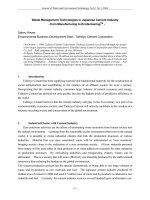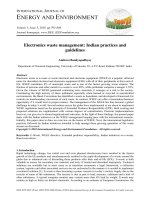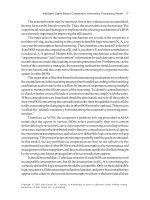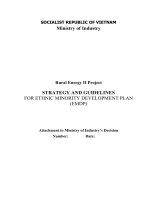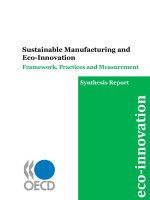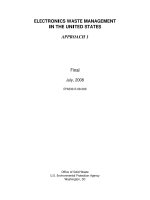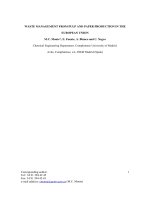Electronics waste management: Indian practices and guidelines
Bạn đang xem bản rút gọn của tài liệu. Xem và tải ngay bản đầy đủ của tài liệu tại đây (161.86 KB, 12 trang )
I
NTERNATIONAL
J
OURNAL OF
E
NERGY AND
E
NVIRONMENT
Volume 1, Issue 5, 2010 pp.793-804
Journal homepage: www.IJEE. IEEFoundation.org
ISSN 2076-2895 (Print), ISSN 2076-2909 (Online) ©2010 International Energy & Environment Foundation. All rights reserved.
Electronics waste management: Indian practices and
guidelines
Amitava Bandyopadhyay
Department of Chemical Engineering. University of Calcutta, 92, A.P.C.Road. Kolkata 700 009. India.
Abstract
Electronic waste or e-waste or waste electrical and electronic equipment (WEEE) is a popular, informal
name for discarded electrical and electronic equipment (EEE) with all of their peripherals at their end-of-
life. WEEE constitutes 8% of municipal waste and is one of the fastest growing waste streams. The
fraction of precious and other metals in e-waste is over 60%, while pollutants comprise a meager 2.70%.
Given the volume of WEEE generated containing toxic materials, it emerges as a risk to the society.
Considering the high toxicity of these pollutants especially when burned or recycled in uncontrolled
environments, the Basel Convention has identified e-waste as hazardous, and developed a framework for
controls on transboundary movement of such waste. In contrast, WEEE can offer a tremendous business
opportunity if it would treat in proper manner. The management of the WEEE has thus become a global
challenge in today’s world. Several nations across the globe have implemented or are about to implement
WEEE regulations based on the principle of Extended Producer Responsibility (EPR). Both existing and
proposed solutions are implemented with various degrees of centralization. Practical implementations
however, can give rise to absurd organizational outcomes. In the light of these findings, the present paper
deals with the Indian initiatives on the WEEE management keeping pace with the international scenario.
Initially, this paper aims to draw an overview on the basics of WEEE. Next, the international legislative
practices followed by Indian initiatives intended to help manage these growing quantities of this waste
stream are discussed.
Copyright © 2010 International Energy and Environment Foundation - All rights reserved.
Keywords: E-Waste, WEEE directive, Extended producer responsibility, Inidan initiatives on e-waste,
Basel convention.
1. Introduction
Rapid technology change, low initial cost and even planned obsolescence have resulted in the fastest
growth of the EE products and simultaneoously resulted in the rapid development of e-waste around the
globe due to enhanced rate of discarding these products after their end-of-life (EOL). E-waste is both
valuable as source for secondary raw material, and toxic if treated and discarded improperly. Technical
solutions are available but in most cases as in transition economies a legal framework, a collection
system, logistics and other associated services are not orchrested in the manner it is needed to implement
a technical solution [1]. E-waste is thus becoming a prime concern in to-day’s society largely due to the
toxicity of some of the substances. The toxicity is due in part to lead, mercury, cadmium and a host of
other substances. A typical computer monitor may contain more than 6% lead by weight. E-waste may
contain as high as thirty-six distinct chemicals. According to an estimate of European Commission, the
International Journal of Energy and Environment (IJEE), Volume 1, Issue 5, 2010, pp.793-804
ISSN 2076-2895 (Print), ISSN 2076-2909 (Online) ©2010 International Energy & Environment Foundation. All rights reserved.
794
total amount of waste in Europe is expected to increase by about 45% between 1995 and 2020. This
forecast has led to the development of European waste strategy based on three categories - waste
prevention, recycling and reuse and environmentally sound disposal [2]. A flurry of research has been
undertaken in the recent past on the sustainability of practices like “recycling and reuse” covering
various types of packaging waste [3–5]. All these studies reported so far were based on single component
waste stream, for instance, aluminium packaging or PET bottles. It is a matter of great uncertainty now
as to whether similar conclusions can also be drawn for more complex waste stream like e-waste or not.
The complexity in composition of each item in the e-waste stream makes it difficult for recycling. This is
further augmented with the sparse user-friendly viable recycling methods. For example, poly brominated
flame retardants (PBFRs) are widely used in plastics meant for the electrical and electronic equipment
(EEE). Due to presence of halogens in PBFRs these plastics are difficult to recycle. The growth of this
waste stream can be generally attributed to the paradigm shift from an industrial society to an
information technology based society with ever increasing use of information and communication
technology (ICT) based devices in particular. According to Cui [6], the production of electrical and
electronic equipment (EEE) is one of the fastest growing areas. Hence, the amount of WEEE is also
increasing very fast - in Europe, at an expected rate of at least 3% to 5% per year and is putting enormous
pressure on all institutions involved in the end-of-life (EOL) management of electronic devices. The
quantum of WEEE generated constitutes one of the fastest growing waste fractions, accounting for 8% of
all municipal waste [7]. These facts have led to vigorous action among legislative bodies across the
globe.
Due to poor environmental standards and working conditions in developing countries of transition
economy, e-waste is being exported to these countries for processing in violation of the Basel
Convention. As a couter measure several countries like Switzerland, Sweden, Belgium, Holland, USA,
Norway, Canada, Japan, Australia have formulated their own regulations for e-waste management [8–10]
while 25 Member States of the European Union (EU) follow EU Waste Electrical and Electronics
Equipment (WEEE) Directive (Hieronymi, 2004). The principle of all these regulatory approaches is the
Extended Producer Responsibility (EPR) manifested with a command and control for its enforcement.
Extended Producer Responsibility (EPR) is a relatively new and market-oriented regulatory instrument.
The Organization for Economic Cooperation and Development defines it as “an environmental policy
approach in which a producer’s responsibility, physical and/or financial, for a product is extended to the
post-consumer stage of a product’s life cycle” [11]. Application of EPR for the original equipment
manufacturers (OEMs) of EEE is certainly appropriate. However, the feasibility analysis has to be
carried out prior to finalization of the policy by the regulatory authorities. It is prudent to carry out an
economic analysis since the policy under question ought to have considerable cost impacts of the
different institutional system designs. Detailed economic analysis includes actual actions and activities in
e-waste recycling practices. Such concerns were missing in the case of the WEEE directive in the
European Union [12].
In India, there is no legislation for the management of e-waste at present excepting inclusion of a few
items of WEEE under the Hazardous Wastes (Management and Handling) Amendment Rules, 2008 [13].
An attempt has therefore, been made in this article to give an overview of the basics of the e-waste,
highlights of the EU, WEEE Directives and finally the Indian initiatives. While discussing legislative
issues it would be prudent to discuss the Swiss regulation as a priori as Switzerland is the first country in
the world to enforce the e-waste regulation.
2. What is electronic waste or e-waste or waste electrical and electronic equipment (WEEE)?
E-waste is a popular, informal name for discarded and EOL EEE comprising Information and
Communication Technology Equipment, Home Electrical Appliances, Audio & Video Products and all
of their peripherals. The standard definition of electronic waste or e-waste does not seem to be available
in the existing literature. However, according to UNEP [14] “e-waste is a generic term encompassing
various forms of electrical and electronic equipment (EEE) that are old, end-of-life electronic appliances
and have ceased to be of any value to their owners”. This is by far the reasonably best definition of e-
waste as of now. A practical definition of e-waste is “any electrically powered appliance that fails to
satisfy the current owner for its originally intended purpose”.
International Journal of Energy and Environment (IJEE), Volume 1, Issue 5, 2010, pp.793-804
ISSN 2076-2895 (Print), ISSN 2076-2909 (Online) ©2010 International Energy & Environment Foundation. All rights reserved.
795
3. WEEE categories
WEEE consists of the ten categories (Table 1) per the definitions in the EU Directive 2002/96/EC [2]. Of
the ten categories listed in Table 1, Categories 1 to 4 account more than 95% of the WEEE generated.
Table 1. WEEE Categories [2]
Sl Cate
gory Label
1 Large household appliances Large HH
2 Small household appliances Small HH
3 IT and telecommunications equipment ICT
4 Consumer equipment CE
5 Lighting equipment Lighting
6
Electrical & electronic tools (with the exception of large-scale stationary industrial
tools)
E & E tools
7 Toys, leisure and sports equipment Toys
8 Medical devices (with the exception of all implanted and infected products)
Medical
equipment
9 Monitoring and control instruments M & C
10 Automatic dispensers Dispensers
4. WEEE composition
WEEE is a complex mixture of Ag, Au, Pd and Pt as precious metals; Cu, Al, Ni, Sn, Zn, Fe as base
metals; Hg, Be, Pb, Cd, Cr(VI), As, Sb, Bi as metals of concern; halogens and combustibles
[plastics/flame retardants] [15] many of which are toxic. It is, however, extremely difficult to present a
generalized material composition for the entire e-waste stream since EEE is composed of various
materials with wide range of physico-chemical characteristics. In general, six categories of materials are,
therefore, reported in most of the studies to complete the inventory, such as ferrous metals, non-ferrous
metals, glass, plastics, pollutants and others. “Pollutants” find a position in these categories to transpire
the polluting behaviour of the WEEE matrix in reality. When WEEE is disposed off or recycled in an
uncontrolled manner, the level of “pollutants” become significantly higher. Besides toxic materials, e-
waste also contains considerable quantities of valuables in the form of precious metals. Recycling of
such wastes, thus assumes significant importance from the commercial standpoint.
Iron and steel constitute the major fraction in the WEEE materials to the tune of 47.9% as against the
plastics as second largest component constituting to about 20.6% [16]. The non-ferrous component
contributes to 12.7% of which Cu weighs 7%. A similar breakup indicating the material composition is
found in the e-waste recycled by Swiss Association for Information, Communication and Organization
Technology (SWICO) / Swiss Foundation for Waste Management (S.EN.S) recycling system in
Switzerland [17] wherein total metals account for 60.20% and plastics to the tune of 15.21%. The plastic
content in WEEE can be understood from the generic plastic resins those were sold in electrical and
electronic sector in the US in significant quantities in 1995 [18]. Approximately seventeen such plastic
resins sold were: Acrylic mostly Polymethyl Methacrylate (PMMA), Acrylonitrile Butadiene Styrene
(ABS), Epoxy (EP), Phenol Formaldehyde (PF), Polyacetal (POM), Poly Amide (PA), Poly-Carbonate
(PC), Poly-Carbonate (PC) / Acrylonitrile Butadiene Styrene (ABS) Blend, Polyethylene (PE),
Polyethylene Terephthalate (PET), Polybutylene Terephthalate (PBT), Unsaturated Polyester (UP),
Polyphenylene Ether (PPE) / High-Impact Polystyrene (HIPS) Blend, Polypropylene (PP), Polystyrene
(PS) (including HIPS), Polyurethane (PU) and Polyvinyl Chloride (PVC).
The six most commonly used resins in EEE were PS (29 %), ABS (14 %), PP (12 %), PU (9 %),
PC (8 %), and PF (5 %) and were found widely varying in their quantities within product categories.
5. Indian scenario of e-waste
The electronic industries have emerged as the fasted growing segment of Indian industries in terms of
production, internal consumption, and export. In the IT action plan, the government has targeted to
increase the present level of penetration, from 5 per 500 people to 1 for 50 people, by 2008. This
envisages applying IT in every walk of the economic and social life of the country. When compared to
the USA, the Indian configuration of 5 PCs per 500 people does not represent any sign of massive rise in
PCs’ obsolescence rate. Though invisible and slow, however, this annual growth rate of 1.65 million PCs
International Journal of Energy and Environment (IJEE), Volume 1, Issue 5, 2010, pp.793-804
ISSN 2076-2895 (Print), ISSN 2076-2909 (Online) ©2010 International Energy & Environment Foundation. All rights reserved.
796
has begun to work in increasing obsolescence rate of IT product. Besides this, of the nearly 5 million PCs
in India, 1.38 million are either 486s or below. Although given that the figure of 1.38 million is quite low
in comparison with the US estimate of 20 million obsolete computers, it represents a growing trend,
particularly in the context of a rising annual growth of 1.65 million new PCs. It was estimated [19] that
over 2 million old PCs ready for disposal India. An estimated 30,000 computers become obsolete every
year from the IT industry in Bangalore alone and was attributed to an extremely high obsolence rate of
30% per annum. The global annual generation of WEEE is given in Table 2. It can be seen from the table
that India is ranked 4
th
amongst the selected countries.
Table 2. E-waste generation in selected nations
Country Rank
Generation
TPA
Categories of Appliances counted in e-
waste
Year Reference
Switzerlan
7 66,042 2003 [20]
Germany 2 1,100,000 2005 [21]
UK 3 915,000
Office & Telecommunications Equipment,
Consumer Entertainment Electronics, Large
and Small Domestic Appliances,
Refrigerators, Fractions
1998 [22]
USA 1 2,124,400
Video Products, Audio Products, Computers
and Telecommunications Equipment
2000 [23]
Taiwan 9 14,036
Computers, Home electrical appliances (TVs,
Washing Machines, Air conditioners,
Refrigerators)
2003 [24]
Thailand 8 60,000
Refrigerator, Air Conditioners, Televisions,
Washing Machines, Computers
2003 [25]
Denmark 5 118,000
Electronic and Electrical Appliances
including Refrigerators
1997 [26]
Canada 6 67,000
Computer Equipment (computers, printers
etc) & Consumer Electronics (TVs)
2005 [27]
India 4 146,180 Electronic and Electrical Appliances 2003 [28]
The annual WEEE generation in India has been estimated to be 146,180 t based on selected EEE tracers’
items [29]. The state wise breakup of generation of WEEE in India is shown in Table 3.
Table 3. WEEE Generation in top ten states in India
Sl. # STATES WEEE (MT)
1 Maharashtra 20270.59
2 Tamil Nadu 13486.24
3 Andhra Pradesh 12780.33
4 Uttar Pradesh 10381.11
5 West Bengal 10059.36
6 Delhi 9729.15
7 Karnataka 9118.74
8 Gujarat 8994.33
9 Madhya Pradesh 7800.62
10 Punjab 6958.46
In India the electronics industry has emerged as the fastest growing segment of Indian industry both in
terms of production and exports. Within this segment, the IT industry is prime mover with an annual
growth rate of 42.4% between 1995 and 2000 [17]. By the end of 2000, India had an installed base of 5
million personal computers (PCs). As per IT industry’s estimates, about 1.65 million PC units were sold
for the fiscal year 2001-2002. The Indian IT industry has a prominent global presence today largely due
to the software sector. Promotion of the software industry and protection of the hardware industry from
external competition has resulted in this skewed growth. More recently however, policy changes have led
to a tremendous influx of leading multinational companies into India to set up manufacturing facilities,
R&D Centres and offshore software development facilities. The domestic market is getting revitalized
International Journal of Energy and Environment (IJEE), Volume 1, Issue 5, 2010, pp.793-804
ISSN 2076-2895 (Print), ISSN 2076-2909 (Online) ©2010 International Energy & Environment Foundation. All rights reserved.
797
due to buoyant economic growth and changing consumption patterns. This growth has significant
economic and social impacts. The increase of electronic products’ consumption rates and higher
obsolescence rate leads to higher generation of electronic waste (e-waste). The increasing obsolescence
rates of electronic products added to the huge import of junk electronics from abroad create complex
scenario for solid waste management in India.
The estimated e-waste in Delhi from PCs is 6803 tonnes with 7 years obsolescence rate and 4082 tonnes
with 5 years obsolescence rate assuming all the obsolete PCs go for dismantling [17]. This estimate is
based on installed base of PCs in Delhi region and findings of the field survey, which indicated that 2
trucks per day of e-waste come to Delhi every day from outside for dismantling. However, tracer
analysis indicates 7 years obsolescence rate of computer, which confirms that approximately 941
computers are dismantled in Delhi every day. Therefore, the PCs, which are being dismantled in 2003-
04, were sold into market around 1996, the beginning of Internet era in India. PCs dismantled may reach
700000 to 800000 per annum by 2010 considering 7 years obsolescence rate.
6. WEEE legislation and activity in Switzerland
Switzerland is the first country in the world to introduce legislation on e-waste management in 1998 in
the form of an Ordinance entitled “The Return, the Taking Back and the Disposal of Electrical and
Electronic Appliances” (ORDEA) [30]. Two separate WEEE recycling systems operate in Switzerland
[31]: the Swiss Association for Information, Communication and Organization Technology (SWICO)
Recycling Guarantee created in 1993 and the Swiss Foundation for Waste Management (S.EN.S) system
established in 1990. SWICO is an association of manufacturers and importers of office electronics and IT
equipment in Switzerland and S.EN.S is a non-profit organization that operates recuperation solutions on
behalf of manufacturers, importers and retailers. They have established a regulation that outlines the
prerequisites for the recycling companies to be commissioned for either of the systems to process the
electronic scrap taken back by the respective system. Both the systems have complete take-back and
recycling programmes financed by an Advanced Recycling Fee (ARF) charged on all new appliances.
The ARF is charged to the customers for collecting, transporting and recycling of the disposed
appliances. The Swiss system is based on EPR—both legally and operationally. Manufacturers and
importers are physically and financially responsible for environmentally sound disposal of EOL
products. Export of e-waste is prohibitive to non-OECD countries since Switzerland is a signatory to the
Basel Convention Ban Amendment. Appliances for disposal are permitted for export as specified under
Section 3 of Article 9 of the ORDEA [30] and having prior consent of the importing country. On this
account, an exporter must ensure environmentally tolerable disposal of e-waste. Illegal import and export
of e-waste to and from Switzerland are prevented by strict surveillance. Also multiple levels of
independent controls enable checking of free riding and pilferage as well as ensure recycling quality and
environmental standards.
SWICO manages “brown goods” such as office electronics, IT equipment, mobile telephones, equipment
used in the graphics industry, telephones and telephone switchboard systems, consumer electronics and
dental equipment. While S.EN.S handles “white goods” namely, refrigerators, washing machines, ovens,
electrical tools, building, gardening and hobby appliances, electrical and electronic toys, as well as
lighting equipment. The Technical Control Body of the Swiss Federal Laboratories for Materials Testing
and Research, EMPA, has a bridging function between the two systems since it is a member of both
organizations. One of the main responsibilities of EMPA is to collect data annually and collation thereof
in respect of material inflow to and outflow of all licensed recycling companies induced by the electronic
scrap taken back in the two systems. In 2003 there were 500 official collection points of SWICO and
S.EN.S around Switzerland in addition to the thousands of retail locations which have to take back old
equipment free of charge, irrespective of the brand or year of manufacture, thereby making it easier for
consumers to dispose of their e-waste at appropriate locations [32]. SWICO and S.EN.S together paid
almost 8% of the total ARF received in 2003, to the collection points. In all, the collection and logistics
expense was representing almost 22.5% of the ARF received. By having common collection points, the
Producer Responsibility Organizations (PROs) are better able to manage logistics, benefit from
economies of scale and provide a consumer friendly, all-inclusive solution instead of a prohibitively
expensive brand specific one. The two systems are well established in Switzerland. In 2004 they enabled
the participating recycling companies to process about 75,000 t of WEEE—which corresponds to about
11 kg recycled WEEE per inhabitant. This figure significantly exceeds the goal of 4 kg recycled WEEE
per inhabitant defined in the European WEEE directive [2]. Even though the 68,000 t of e-waste
